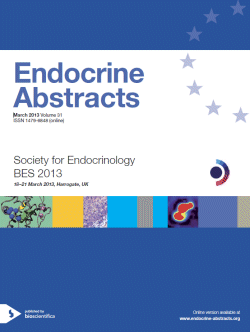Young Endocrinologists Session
Young endocrinologists' prize lectures
ea0031yep1.1 | Young endocrinologists' prize lectures | SFEBES2013
Clinical and pre-clinical studies of neuroendocrine tumours (NETs) in multiple endocrine neoplasia type 1 (MEN1), and evaluation of MEN1 gene replacement therapy for MEN1-associated NETs.
Walls Gerard , Newey Paul , Lemos Manuel , Javid Mahsa , Piret Sian , Reed Anita , Thakker Rajesh
ea0031yep1.2 | Young endocrinologists' prize lectures | SFEBES2013
The Wnt/β-catenin effector Tcf3/TCF7L1 is required for normal hypothalamic–pituitary development
Gaston-Massuet Carles , McCabe Mark , Wu Chun-I , Gharavy S. Neda Mousavy , Koniordou Markella , Merrill Bradley J , Dattani Mehul , Martinez-Barbera Juan Pedro




